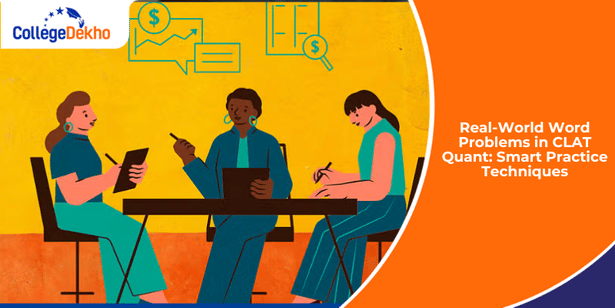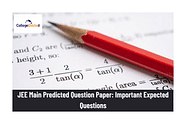
Real-world word problems in CLAT 2026 quant section are a frequent part of the exam, and as a CLAT exam aspirant, you must know how to effectively solve these questions for a better score. Although real-world problems may seem new to you, the underlying problem is related to topics commonly asked in CLAT like Data Interpretation, Percentages, Averages, Profit & Loss, etc. Referring to the smart practice techniques for CLAT quant questions can help you use your preparation time wisely.
Also Read:
Types of Real-World Word Problems in CLAT Quant 2026
Real-world word problems in CLAT quant are just high-weightage topics from the CLAT Quantitative Techniques syllabus with a realistic scenario. Check the table below to find the common types of real-world word problems in CLAT Quant:
Problem Type | Sample Question | Step-by-Step Solution | Final Answer |
|---|---|---|---|
Average Marks | Scores = 60, 75, 80. What is required in the 4th subject for a 70 average? | Required total = 70×4 = 280. Current = 215. Needed = 280 − 215 = 65. | 65 |
Data Interpretation (Revenue) | Product A: Q1 = 250 units, Q2 = 325 units, Price = ₹40. Find the % revenue increase and Q2 profit at a 10% margin. | Rev Q1 = 10,000; Rev Q2 = 13,000. Increase = 3,000 ⇒ 30%. Profit = 10% of 13,000 = 1,300. | 30% increase; ₹1,300 profit |
Mixture / Ratio | Vendor mixes juices in a 3:2 ratio. Cost: ₹30/litre and ₹20/litre. He wants 20% profit. Find selling price/litre. | Cost/ litre = (3×30 + 2×20)/5 = 26. SP = 26 × 1.20 = 31.20. | ₹31.20 |
Profit & Loss with Discount | A shopkeeper buys an item at ₹5,000. He gives a 20% discount on MRP and still makes 10% profit. Find the MRP. | CP = 5000; Profit 10% ⇒ SP = 5500. SP = 0.80 × MRP ⇒ MRP = 5500 ÷ 0.80 = 6875. | ₹6,875 |
Time, Speed & Distance | A car goes 120 km at 40 km/h and returns at 60 km/h. Find the average speed. | Total distance = 240. Time = 120/40 + 120/60 = 3+2=5 hrs. Avg speed = 240/5 = 48. | 48 km/h |
Also Read: CLAT 2026 English Questions
CLAT 2026 Quant Smart Practice Techniques
The following smart practice techniques will significantly enhance your preparation and boost your confidence:
Technique | How to Apply | Why It Works in CLAT Quant |
|---|---|---|
Error Log Method | Maintain a notebook of every mistake → mark whether it was due to a concept gap, calculation slip, or misreading. | Prevents repeating the same errors; improves accuracy over time. |
Focus on Core Topics First | Master percentages, ratios, averages, profit & loss, time–speed–distance, and work before rare topics. | These 5 - 6 topics cover over 70% of CLAT Quant questions. |
Formula & Shortcut Sheet | Prepare a one-page sheet with key formulas, %–fraction equivalents, and ratio tricks. Revise before practice/mocks. | Boosts recall under pressure, reduces calculation time. |
Mix Old & New Questions | Revise past CLAT Quant questions, then solve similar ones from prep books/mocks. | Keeps practice exam-oriented, not just theory-heavy. |
Mock Test Integration | Attempt 2–3 full mocks per week, then re-solve Quant questions you got wrong without time pressure. | Improves speed + accuracy and identifies weak spots in real exam conditions. |
Practice Caselet/DI Sets Daily | Solve 1–2 passage-style sets (tables/ graphs/ word caselets) under a timer. | Most CLAT Quant is data interpretation-based; it builds reading + calculation speed. |
Timed Practice Blocks | Do 15–20 minute drills with 5–7 questions instead of untimed practice. | Builds exam stamina and enforces smart time budgeting (1 min per Q). |
Use Approximation & Estimation | Convert fractions ↔ percentages (e.g., 1/3 = 33.3%). Round off numbers when exact values aren’t needed. | Saves time in lengthy DI calculations and avoids calculator-style thinking. |
This was all about Real-world word problems in CLAT 2026 quant!. Check out the links below to learn more!
Related Articles:
How Mock Interviews Influence Success in the CLAT Admission Process | |
|---|---|
Effective Cloze Test Strategies for CLAT 2026 English Section |
For any admission-related guidance, call our toll-free number 1800-572-9877, or fill out our Common Application Form (CAF) . Stay tuned with CollegeDekho for more updates related to MBA admission and colleges!
Are you feeling lost and unsure about what career path to take after completing 12th standard?
Say goodbye to confusion and hello to a bright future!

FAQs
Yes, CLAT Quant smart practice techniques like timed drills, error logs, approximation skills, and mock analysis can be applied to Logical Reasoning, English, and Legal sections for better accuracy, speed, and confidence.
You should spend about 12–15 minutes on each CLAT Quant question. Aim for quick reading, smart approximations, and accuracy, attempting only the solvable ones to maximize score without wasting time.
You should start your CLAT Quant preparation at least 8–10 months before the exam. Begin with the basics, gradually move to DI sets, and in the last 3 months, focus on mocks and revisions.
There is no fixed number of mock tests you should attempt for CLAT quant preparation. Aim for 30–40 full-length mocks before CLAT, with at least 2–3 weekly. Additionally, solve 15–20 sectional Quant mocks to strengthen speed, accuracy, and familiarity with passage-based questions.
The best exam strategies for CLAT quant section include focusing on high-weightage basics, practicing DI sets daily, using approximations, managing time smartly, attempting easy questions first, and prioritizing high accuracy over guesswork.
Was this article helpful?




















Similar Articles
CLAT GK on Environmental Conventions: Key Treaties and Agreements to Know
Last-Minute Mistakes in AIBE 20 Exam 2025 You Must Avoid
How to Use Bare Acts in AIBE 20 Exam 2025?
How to Crack CLAT 2026 Dual Passage Reasoning Questions
Key Environmental Reasoning Sets for CLAT 2026: Law Meets Logical Analysis
CLAT 2026 Application Form Link: Last Date (Nov 7), Steps to Apply, Documents Required, Application Fee